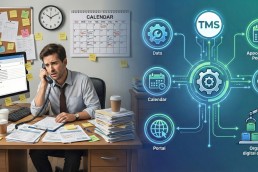How do you Automate Email Appointment Scheduling in Logistics?

While various methods exist for scheduling freight appointments, including online portals, one communication channel stands out due to its widespread use: email. According to the source, “over 60% of facilities are scheduling over email”. This includes a broad spectrum of businesses, from “your largest food and beverage customers down to your mom and pop facilities”. Given its dominance, automating email-based scheduling is not just an option; it’s presented as one of “the biggest pieces that needs to be automated”.
Automating a process that heavily relies on unstructured email communication presents unique challenges compared to automating interactions within standardized portal fields. One key challenge is gathering the necessary information from the carrier side to initiate the appointment request. Traditionally, this might involve a scheduler finding relevant details and manually copying and pasting them into an email draft. Effective email automation needs to capture this required information seamlessly, eliminating the need for manual data transfer. The source indicates that this component has been successfully addressed by their solutions.
The second major hurdle is the facility’s response. The goal of automation isn’t to force the facility to adopt new technology or drastically change their existing workflow. Instead, the automation must adapt to their preferred method of communication. Solutions designed for email scheduling achieve this by allowing facilities to respond in ways that are easy and familiar to them. Two primary methods are offered: a simple “click to confirm experience” within the email itself, or the ability for the facility to “just to reply back like you normally would to an email”.
This flexibility in accommodating the facility’s process has yielded impressive results. Through these methods, solutions have been able to achieve “over 65% in auto confirmations from the facility side”. This represents a significant leap in efficiency. Traditionally, receiving an email confirmation from a facility required a representative to manually “read capture the information and then put that back into their TMS”. By automating the capture and processing of these responses, a substantial amount of manual effort is eliminated.
The adoption of these simplified response methods, both the click-to-confirm and the standard reply-back, demonstrates their effectiveness and acceptance by facilities. By successfully automating the prevalent email-based workflow, companies can unlock significant efficiencies and streamline a historically manual and time-consuming process.


